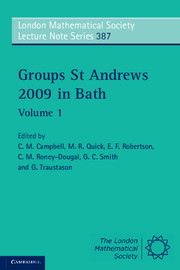Book contents
- Frontmatter
- Contents
- Introduction
- A speech in honour of John Cannon and Derek Holt
- Finite groups of Lie type and their representations
- Iterated monodromy groups
- Engel elements in groups
- Some classes of finite semigroups with kite-like egg-boxes of D-classes
- Structure of finite groups having few conjugacy class sizes
- Group theory in cryptography
- A survey of recent results in groups and orderings: word problems, embeddings and amalgamations
- A survey on the minimum genus and maximum order problems for bordered Klein surfaces
- On one-relator quotients of the modular group
- Miscellaneous results on supersolvable groups
- Automorphisms of products of finite groups
- A rational property of the irreducible characters of a finite group
- Automotives
- On n-abelian groups and their generalizations
- Computing with matrix groups over infinite fields
- Trends in infinite dimensional linear groups
- Engel conditions on orderable groups and in combinatorial problems (a survey)
- References
On one-relator quotients of the modular group
Published online by Cambridge University Press: 05 July 2011
- Frontmatter
- Contents
- Introduction
- A speech in honour of John Cannon and Derek Holt
- Finite groups of Lie type and their representations
- Iterated monodromy groups
- Engel elements in groups
- Some classes of finite semigroups with kite-like egg-boxes of D-classes
- Structure of finite groups having few conjugacy class sizes
- Group theory in cryptography
- A survey of recent results in groups and orderings: word problems, embeddings and amalgamations
- A survey on the minimum genus and maximum order problems for bordered Klein surfaces
- On one-relator quotients of the modular group
- Miscellaneous results on supersolvable groups
- Automorphisms of products of finite groups
- A rational property of the irreducible characters of a finite group
- Automotives
- On n-abelian groups and their generalizations
- Computing with matrix groups over infinite fields
- Trends in infinite dimensional linear groups
- Engel conditions on orderable groups and in combinatorial problems (a survey)
- References
Summary
Abstract
We investigate the modular group as a finitely presented group. It has a large collection of interesting quotients. In 1987 Conder substantially identified the one-relator quotients of the modular group which are defined using representatives of the 300 inequivalent extra relators with length up to 24. We study all such quotients where the extra relator has length up to 36. Up to equivalence, there are 8296 more presentations. We confirm Conder's results and we determine the order of all except five of the quotients. Once we find the order of a finite quotient it is easy to determine detailed structural information about the group. The presentations of the groups whose order we have not been able to determine provide interesting challenge problems.
Our study of one-relator quotients of the modular group is ‘in the small’, that is, with a short extra relator. We briefly compare and contrast our results with generic results.
Introduction
The modular group is a much studied object in mathematics. Indeed in the documentation for the award of the 2009 Abel Prize to Mikhail Gromov, this group is described as “one of the most important groups in the modern history of mathematics”. It is perhaps best known as the projective special linear group L2(ℤ), with a standard representation as a group of linear fractional transformations. It has a large collection of interesting quotients, including most of the nonabelian finite simple groups.
- Type
- Chapter
- Information
- Groups St Andrews 2009 in Bath , pp. 183 - 197Publisher: Cambridge University PressPrint publication year: 2011



